3/3/11 to 13/3/11 642km (total for the whole journey 32,378km)
‘Crossing the Magallanic Straight and into the Land of Fire’
The Magallanic straight that divides the mainland of South America from Tierra del Fuego was discovered by and hence named after the Portugese explorer Ferdinand Magellan. Magellan named the island that was cut-off from the mainland ‘Tierra del Fuego‘ for the numerous fires of the indigenous Yaghani people he observed on the shoreline when they arrived. In fact it was originally known as the 'land of smoke' but 'land of fire' obviously had a better ring to it, so it stuck.
For us arriving to Tierra del Fuego there were no fires or smoke from the beach. The Yaghani population had long been pursecuted, hunted and forcibly removed from their lands. Now just golden treeless hills rise out of the choppy waters of the straight and seaweed lines the beaches. We were accompanied into the bay of Chilota by a small pod of white-sided dolphins riding the bow waves of the ferry. The 5kms riding into Porvenir was absolute madness on the road with a ferry load of traffic and local taxis zipping along, overtaking on blind corners and driving like their lives depended on arriving in town in less than a minute. When we had weathered the storm and arrived into the sleepy village we wondered what all the rush was about. The place was basically deserted apart from a small general store, the bakery and the hardware store. I half expected to see tumbleweeds roll across the streets and there was no sign of the mass of traffic that had nearly blown us off the road just 10 minutes earlier. Porvenir was a strange place indeed but at least we could load up on fresh bread for the coming four or so days to Rio Grande.
‘Dispelling the myth that Tierra del Fuego is flat!’ on the coastal road
Without wasting more time we headed out of town and westward onto a good ripio road that rolled over a few hills before rejoining the coastline of Bahia Inutil. We had heard from many cyclists that Tierra del Fuego is a boring place to cycle. Flat, monotonous, treeless, windy and flat. Did I mention flat? Well, I don’t know if they had ridden the same roads as we were riding on, because it was spectacular and definitely not flat as we climbed high above the cliffs with the blue sea below us before dropping down once again to seaweed strewn gravelly beaches before another pinching steep climb to another high vantage point over Bahia Inutil. And in this manner the coastal road continued.

Beautiful coastal riding out from Porvenir, far from flat and boring!

Prado enjoying one of the many pinch climbs along the Tierra del Fuego coastline
And windy? Well yes it was definitely windy. So windy in fact that there are
only two spots where cyclists recommend camping for the stretch between
Porvenir and San Sebastian. One is at 56km from Porvenir, a bunch of
lone trees where we had planned to stop for the night. No trees in
sight, nothing, until at 56km on the dot a small grove of trees
surrounded a taller cypress tree appeared to the left up in a field.

It
only required a quick lift over a fence (crossing fences is not
something we usually do but when the moment demands it...) and a short
wheel through the grass to our home out for the night out of the wind.
‘En busqueda de pinguinos’ / ‘In search of penguins’
We had heard from our biking friends Hugh and Pauline and also from our Lithuanian friend Henry that there was a king penguin colony of fifty or so penguins hanging out on the wind blasted shores of Bahia Inutil between the turnoff from the Porvenir-San Sebastian main road, and Cameron. Their details of where we might find them varied a little from “at 14.8km there will be a little dirt track to your right, jump the fence, wade across the river and they’ll be there” to “cross the bridge and just before the big hill there is a green gate to the right, walk 200 yards to the beach and they’ll be there”. Sounds simple enough. When we took the second piece of advice (as it had been much more recent) and arrived at the beach our hearts sank into the sand. Not a king penguin in sight, a few footprints of some bird, a few dead magallanic penguins washed up in the cemetery of seaweed, feathers and bones, but no majestic kings of the ocean standing tall in their back and white suits on the desolate beach. We had had such high hopes, and as a result we were totally deflated and shattered. We dragged our feet back over heavy sand dunes, over barbed wire and back to our bikes without saying a word to one another.
The wind was going to be stiffly in our faces and none of us favoured the prospect of pedalling into the wind the 35 or so kilometres to Cameron. So we climbed halfway up the hill near Estancia Tres Hermanos, and after assessing a small metal sheeted shelter surround by bones and sheep carcasses, we settled on a more suitable campspot closeby, out of the wind, and out of sight from the road in a depression on the eastern side of the road.
By 5:45pm we started to think about dinner preparations, and I thought to myself “This doesn’t make sense. They have to still be there. They were there a week ago”. So, I took off alone back to the beach but to check closer to the river. I parked my bike, jumped the fence and made my way over a grassy rise towards the river and then I saw them. Like something out of a surrealistic dream, some seventeen king penguins standing around by the river trying to avoid the wind. They were as surprised to see me as I was to see them, but they weren’t scared, in fact very interested in me looking me up and down as if to say “Who are you and what are doing on our patch of grass down by the river?...Oh, that’s alright you can join us if you like!”. Then I noticed another eleven penguins braving the cold and the wind on teh exposed beach across the river. With my heart in my mouth I couldn’t get back to the others soon enough to break the news.
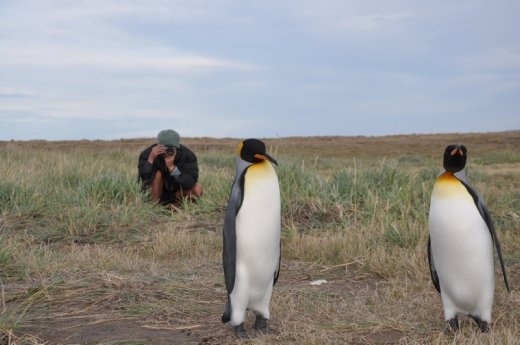
Anna, prado and myself then spent a magical hour sitting close-by these beautiful creatures of the southern islands and oceans watching their antics of wing slapping, chest pushing, head raising, belly sliding, grunting and eye poking behaviour.


But the question has to be asked. Just why are twenty-seven or so king penguins hanging out in Bahia Inutil? Lost, visiting, resting or recolonising? They just shouldn’t have been there say the books and the experts, "they must have followed their food source deep into the bay" says one Marine Biologist from Estancia Harberton. So, are they lost having followed their food into a big dead-end bay with only one way out, west into the current? Are they just resting there or moulting? Or are they recolonising on Tierra del Fuego? I guess we may never know. They all seemed in good condition, and they obviously enter the sea every day to fish. But they were not breeding or bringing chicks up, and maybe if they did they would fall prey to foxes or dogs. A real mystery. But for us a fortunate encounter that normally you would have to travel to distant sub antarctic islands or Antarctica itself to see, but for us we could ride our bikes to within 50 metres of the colony.
When we went back to the next morning to show Guillaume they had disappeared again. Nowhere to be seen on the whole beach. Twenty-seven, one metre tall king penguins had just vanished into the beach sand...or more than likely they had just gone fishing!

The next 35 kilometres to the tiny outpost of Cameron hugged the rugged
coastline, dropping down to meet the rivers draining into the sea before
climbing back up to the higher cliffs. Grey, windy and the barren
pampa, it was reminiscent of the barren moors of Scotland. No wonder so
many british migrants settled in Patagonia and Tierra del Fuego on the
estancias as sheep farmers. This grey sky, dull light and the raging
wind must have made them feel right at home.
Cameron itself could perhaps receive the title of ‘the end of the world’ maybe more so than Ushuaia or Bahia Lapataia. The little outpost of a town with a scottish name, a main street, a few houses, a football pitch, a run-down old square and a small shop with a few cans of beer but no bread, was once an important centre for the farming community and the estancias on Chilean Tierra del Fuego. Now it felt like the rest of the world had forgotten about it. Only a couple of playful puppies joined us in the streets with barely a soul about on the streets.
Leaving town we paused at the sea. Shimmering grey with beams of sunshine breaking through the dark sky, and an impressive westerly wind blowing cold salt laden air onto our faces. Anna looks at me and tells me to enjoy what this feels like, this impressive feeling of isolation. “This is the end of the world!” she exclaims. I could tell by the smile on her face that she was enjoying what Tierra del Fuego had given to us so far. And so, we climbed back out from the narrow valley past the wooden sculpture of three Yaghani Indians in a canoe and then turned due east with the wind behind our saddles pushing us towards Argentina.
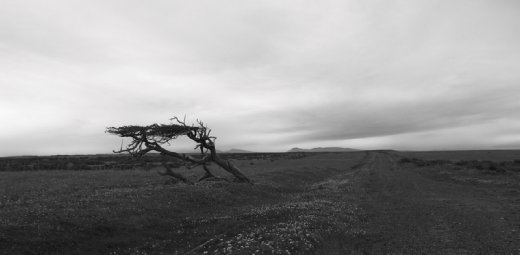
Lone windswept beech tree just out from Cameron. Luckily for us we were heading east (left in the photo) with the wind in our backs!
Nearing the end of a long day in the saddle, we had just passed some ideal wild camping options when the trees thinned out, the fences began again and we arrived at Estancia Cameron Seccion Russfin. We enquired about the possibility of camping somewhere out of the wind on the estancia. At first they weren’t too forthcoming with ideas or options until we invited ourselves to camp behind the old shearers quarters buildings. Soon afterwards, Cristobal, the young dreamy blue-eyed guacho who was in charge of the place arrived and showed us into the newer shearers quarters, complete with pot-belly fire, wood, and a number of rooms where we could roll our sleeping mats out on the ground. It is only used twice a year for the small number of shearers who come there to work, so we could make ourselves at home. Just to be out of the wind in the evening was a luxury in itself. So we stoked up the pot-belly fire, cooked dinner on the floor, shared stories in the warmth and enjoyed another night of friendly (if a little extorted) chilean hospitality.
Cristobal had had an immediate impact on both Anna and Prado with his blue
eyes, a rather uncommon trait of a Chilean man to go with his dark hair. Surprisingly the girls were a little breathless.

Anna leaving another comfortable place of rest out of the elements at Seccion Russfin courtesy of Cristobal, the dreamy blue-eyed guacho.
On 'Guanaco Safari'
After leaving Seccion Russfin the trees thinned out, and the golden pampa began with the dark mountains of the distant Cordillera Darwin as the backdrop. We were on some sort of ‘guanaco safari’ with herds of up to 30 or 40 individuals on both sides of the roads.
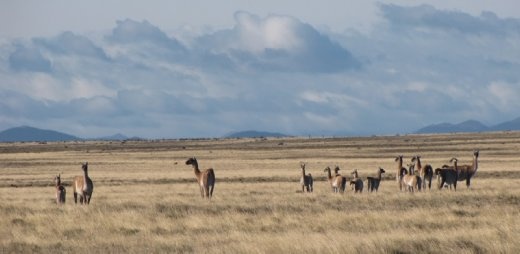
Sometimes an individual or a small herd would cross the road and clear
the fence in quick, well timed leaps. Other times they retired a
comfortable
distance from the road before stopping to observe us, the strange
creatures
on bicycles. This was normally associated with the lone male guanaco 'el
relincho' squealing and wheezing his disapproval at us while his harem
and young got in behind him.

Anna and a field full of guanacos, crossing the valley of the Rio Grande
Cristobal had told us that there were something in the order of 25000 guanacos on Tierra del Fuego from the last population census. Compare that to that one estancia which has 40000 sheep. Obviously the guanacos compete a little for the pasture but the number of sheep must outnumber guanacos significantly. Still the guanaco is seen as a pest, similar to the kangaroos in certain parts of Australia and as a result they had plans to cull some 3500 gaunacos next year. An interesting debate as always if a wild animal threatens the production of domesticated livestock. Our theory is that yes there are lots of guanacos on TDF. More than pre-european colonisation, who knows? But the absence of the puma on TDF ironically due to it being hunted to local extinction by european colonists is the key to the larger numbers of guanacos and especially the numerous young ones that we saw that survive to adulthood. But sheep farming for wool and for meat rules the ‘law of the land’ in TDF.
'One more river to cross' - Crossing the Rio Radman into Argentina

Bags off and wet feet, but a surprisingly easy crossing with water barely coming up to our shins in the 'trickle' that was the Rio Radman in early March. And like that, with our bikes hoisted over our shoulders and without shoes on, we had arrived back into Argentina!
It was only early still once we had negotiated the ‘shin-high’ river crossing but with the view of the road ahead with no trees and bare Argentinian pampa as far as the eye could see we had no problems asking at the Migration office if we could camp there the night. “Sure, why not, not a problem! Take your pick, over there, or over there by the trees” was the response by the tracksuit wearing police official. So we were able to pitch under some large ‘lengas’ sheltered from the wind, as far away from the noisy generator as possible, wash in the river and enjoy a long relaxing afternoon in the sun. All at another free ‘border camp’. We forgot to notice the stripped guanaco carcass complete with head hanging over the top wire of the fence just ten metres from our tent until the next morning.
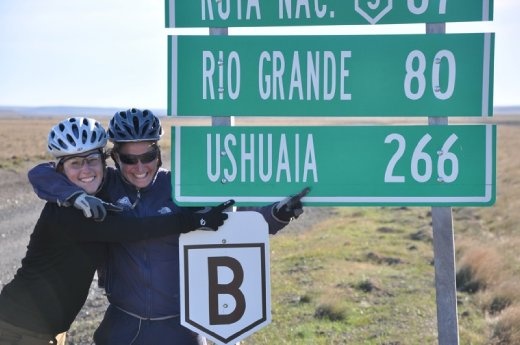
Ushuaia was finally on the map, only 65km of bad Argentine ripio to the 'Ruta 3', and only 266km to Ushuaia...Prado and Anna seem happy about that!

The final wind assisted km's heading east towards Rio Grande "look, no pedalling required!" says Prado, and the ripio to Argentina's credit had improved.

Norma (in the middle) who looked after us at the 'Club Nautico'(Sailing Club) in Rio Grande where most cyclists bunk down in the upstairs gymnasium for a few days to a few weeks. We detoured 18kms into the wind to get there at the far edge of town, but well worth it for a rest day in comfort.
From Rio Grande we were lucky that we had waited a day, because the morning that we left there was barely a breeze and with what breeze there was, it was from the north-west. Almost unheard of! So we left the industry of Rio Grande behind and with the wind at our backs we headed south towards Tolhuin and gradually back into the forested lands and with the mountains getting closer and closer in front of us we knew that we would not be riding in the pampa again!

10km out from Tolhuin we saw the figure of two bicycles coming towards us. 5 yr old Gabrielle (who sits on the front), his mum Veronique from France and ....... from Canada three days in to their four month biking journey to Lima from Ushuaia. We almost shed tears when we met these guys. Tears of joy but also of concern. It was already late in the season and they had so much ahead of them on their journey. The wind, the pampa, the Carretera Austral, the lakes and Araucania, the altiplano and the desert. Which meant headwinds, rain, gravel roads, freezing cold nights, and potentially snow but which also meant the adventure of their lives. I think we also felt emotional because we found out that they had followed our stories and that we had helped inspire them for their trip. I think this goes a long way in answering the question "just why do we do the things that we do? Why do you ride your bike from Alaska to Argentina?" The most important result of our journey is that perhaps we have helped inspire people to live their dreams too, to get out there and take on the world on two wheels. And here it was right in front of us, just two days from our journeys end! They said to us "You guys are our inspiration!". But after seeing them loaded up, with a 5 yr old boy in front, with four months of adventure and trials ahead of them, they were our heroes! All the best guys!
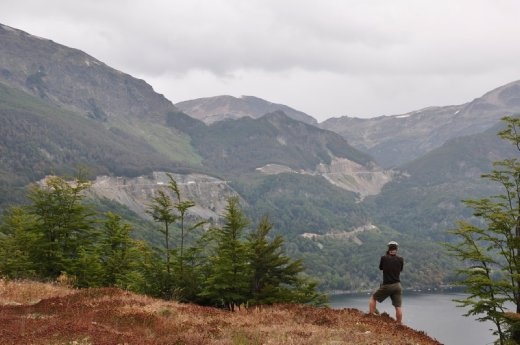
Here I am surveying the final pass of the trip, Paso Garibaldi. I still remember the first big climb in Alaska like it was yesterday wondering "just how many climbs like this lie between Alaska and Ushuaia?" Then it was down to just one...and it started to rain!

But on the otherside of Paso Garibaldi we were bathed in sunshine and the colours on the mountains were glowing in the light. The dark green of the evergreen forest, the beech starting to turn orange, the bright green alpine grasses and the grey rocky scree slopes. And we were heading down to the valley in search of our final campspot.

Which we found here some 35km short of Ushuaia complete with fireplace, sunshine, endless supply of wood and mountain views. Many 'lasts' over the final few days riding. The 'last' time we would be scanning the roadside in search of a suitable wildcamp. The 'last' campfire...
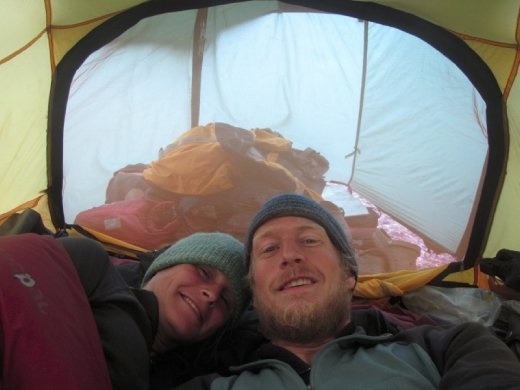
The 'last' time we slept in all of our thermals and beanies. The 'last' time I dragged myself out of the tent in the cold to prepare breakfast. The 'last' time Anna rolled up the sleeping mats and sleeping bags like the tireless campaigner she is...
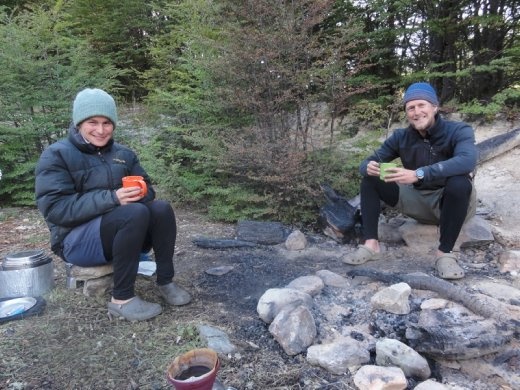
The 'last' mug of sticky porridge and definitely the 'last' time we wear crocs, and shorts over thermal pants for the fun or it!
On the final downhill into Ushuaia, amazingly we rounded a bend to find Prado and Guillaume talking to two
Japanese cyclist. "No, it can't be! But it is...It's Ken!"
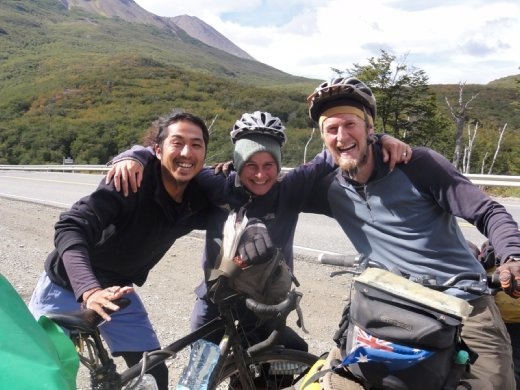
The last time we had seen Ken was in Guadalajara, Mexico some 2 years earlier along with our other Good Japanese cycling friends Nobu and Hiro. And now he had flown into Ushuaia from Santa Cruz Bolivia and was heading back north to join the dots. What a small world the biking community continued to be, right to the end!
And then on the 11th of March 2011, after 32328 km and nearly three years on the road we arrived into Ushuaia with a whole range of emotions and a few tears of elation...
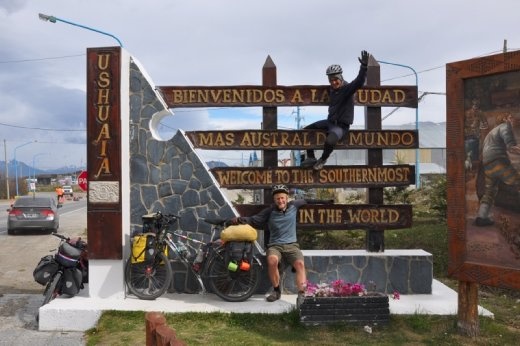
Anna still had plenty of energy climbing to the top, while I was more than happy to sit back and relax and enjoy the moment of arriving at the monument to 'Ushuaia - La Ciudad mas Austral del Mundo' ('Ushuaia - the southernmost city in the world').

The view from 'La Pista Andina' camping above the city of Ushuaia, an effort to get to after some celebratory beverages and empanadas with Prado and Guillaume, but well worth the effort with stunning views across the Beagle Channel. For the next two days the weather deteriorated with rain showers turning to snow showers so we sat in the warmth of the camping refuge watching the snow fall outside, looking across to the snow capped mountains, glad that we had arrived when we did and able to reflect upon the end of the journey.
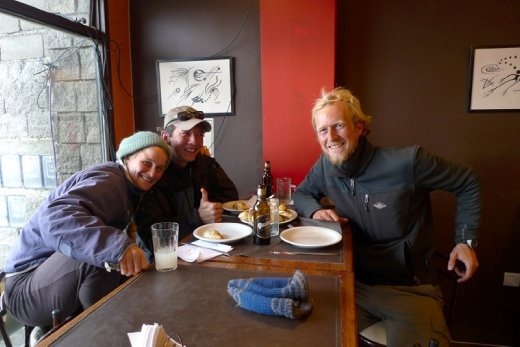
The snow and bad weather was perfect for catching up with our Colombian biking friend Carlos (Pedaleando Alma) for empanadas, coffee and beer. Carlos had been recuperating in Ushuaia from a problem with his achilles tendon. Once he was recovered he would be returning back north to his homeland via the east of South America in over another year.
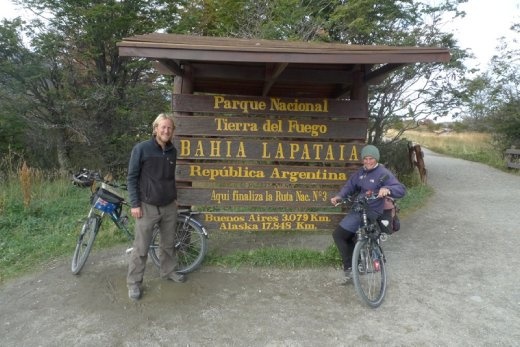
Then after the weather had improved a little we rode the final 28kms of road to the 'end of the road' at Bahia Lapataia, PN Tierra del Fuego for the mandatory photo opportunity. I had also managed to break the rail on one of my ortlieb panniers on the way there. Another subtle reminder that we had reached the end of our journey and it was time to stop.

And there on the shores of the Beagle Channel just as one journey was coming to an end, I dropped to one knee and asked Anna to join me on another journey. Maybe the biggest adventure of our lives to come, to be my wife! Luckily for me she said "yes", otherwise it would have been a bit awkward! And yes, that is a 16 tooth rohloff rear sprocket engagement ring with over 10000kms of love, sweat and tears.
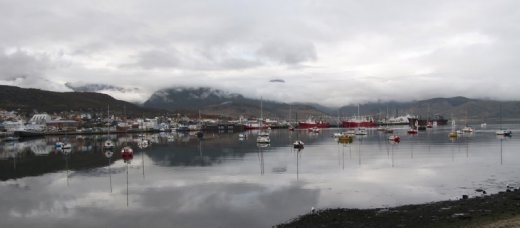
The harbour of Ushuaia and clouds draped over the surrounding mountains.
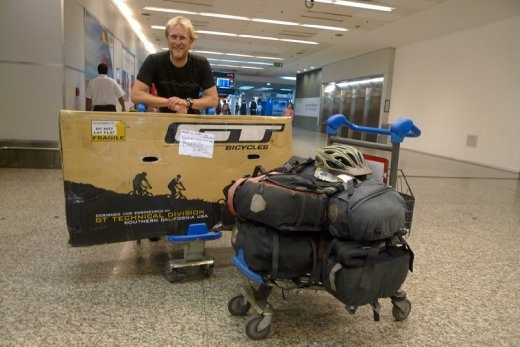
Ali and the bikes all boxed up at Buenos Aires airport.
'this is the end, beautiful friend, the end...'
This is what it came down to in the end - two bikes in boxes, our panniers and a couple of backpacks on our way home after reaching the end of the world.
But it's not really the end. Only the end of the line on a map and the end of the Americas. But our journey continues...
Thankyou all for following the journey with us from the beginning to the end. Without the love and support from our family and friends we would never have had the courage to step out on such a journey. And without the generosity, hospitality, warmth, love, openness and humour of all the people who have welcomed us into their homes, shared meals with us, offered us cups of tea, ridden a mile or a month with us, and offered us help throughout the past two years and 10 months, this adventure just would not have been possible. So thankyou all!

Peace, love and tailwinds from the Fuego team Ali and Anna
ps stay tuned...maybe there will be more from us post trip!
Also lots of photo credit for all the photos of us, to Prado and Guillaume, our biking companions for all of Tierra del Fuego. Gracias amigos!